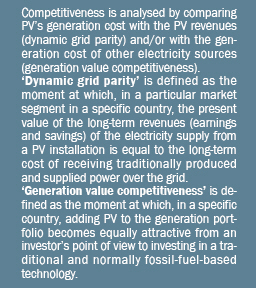Solar photovoltaic technology has proven in recent years that, with the appropriate regulatory framework in place, it can be a major contributor to reaching the EU¡¯s target of 20% Renewable Energy Sources (RES) by 2020. Technology improvements and economies of scale have spurred steady cost reduction, which will continue in coming years as the PV industry progresses toward competitiveness with conventional energy sources.
But already today, PV electricity is cheaper than many people think. In the coming years the technology will become even more cost-effective and competitive¦¡and qualify, therefore, as a vital part of Europe¡¯s energy future. Under the right policy and market conditions, PV competitiveness with grid electricity can be achieved in some markets as early as 2013, and then spread across the continent in the different market segments by 2020.
To study these trends and consider the conditions under which PV will reach full competitiveness, EPIA has conducted an extensive analysis of 5 markets (France, Germany, Italy, Spain and the United Kingdom). The study, carried out with the support of the strategic consulting firm A.T. Kearney,
shines new light on the evolution of Europe¡¯s future energy mix and PV¡¯s role in it. The study finding are shared in this article.
.jpg)
Decreasing Prices and PV¡¯s Generation Cost
Over the last 20 years, PV has already shown impressive price reductions, with the price of PV modules decreasing by over 20% every time the cumulative sold volume of PV modules has doubled. System prices have declined accordingly; during the last 5 years a price decrease of 50% has been achieved in Europe. System prices are expected to decrease in the 10 coming years by 36-51% depending on the segment.
Importantly, there is a huge potential for further generation cost decline: around 50% until 2020. The cost of PV electricity generation in Europe could decrease from a range of 0.16-0.35 ¢æ/kWh in 2010 to a range of 0.08-0.18 ¢æ/kWh in 2020 depending on system size and irradiance level.
.jpg)
A Competitive Solution Well before 2020
Before the end of this decade, PV will offer every European citizen the chance to become a ¡®prosumer¡¯, producing and consuming his or her own decentralised source of electricity at a competitive price.

Competitiveness of PV electricity for final consumers is defined as ¡®dynamic grid parity¡¯. With different solar irradiance levels from South to North in the largest European countries, and different market segments, dynamic grid parity will not happen at exactly the same time everywhere in Europe. Given the possible decline in generation cost, dynamic grid parity could be achieved as early as 2013 in Italy in the commercial segment and then spread all across the continent in the different market segments.
Generation value competitiveness could be reached as early as 2014 in the groundmounted segment in Italy and then spread out in Europe to many additional countries by 2020.
While the cost of generating PV electricity will reduce sharply in Europe in the coming decade, any further increase of electricity prices¦¡from 2% to 6.7% yearly on average depending on the respective country considered¦¡will shorten the time needed for PV to become competitive. These rather conservative assumptions are based on historical growth rates.
Sustainable Support Schemes
 Smart deployment of support mechanisms, such as Feed-in Tariffs (FiTs), has helped PV gain a market foothold in many countries of the world, compensating for the difference in cost competitiveness between PV electricity and that of conventional sources.
Smart deployment of support mechanisms, such as Feed-in Tariffs (FiTs), has helped PV gain a market foothold in many countries of the world, compensating for the difference in cost competitiveness between PV electricity and that of conventional sources.
As that competitiveness gap narrows for the PV sector, due to technology development and parallel decrease of generation cost, PV will be able to rely progressively less on dedicated financial support, leading to the phasing out of such support schemes. This will happen even quicker if internalization of external effects is implemented for all technologies and subsidies to other energy sources are also phased out, leading to a truly level playing field. Achieving competitiveness should not automatically mean the end of all incentives. Policymakers will need to consider softer sustainable support mechanisms aimed at preserving PV¡¯s vital place in the energy mix.
Renewable energy sources, including PV, will be essential to achieving Europe¡¯s important goals of reducing greenhouse gases and guaranteeing the security of a safe and local energy supply. Encouraging PV development will also play a major role in the EU effort to create a smart, sustainable economy for the future¦¡one in which high-tech innovation creates jobs and social cohesion. But an appropriate regulatory framework and favorable market conditions will be needed to ensure that PV can roll out its full and increasingly promising potential in our future energy mix.
Switching to solar photovoltaic electricity is not just a desirable option for achieving our energy and environmental goals; it is also a realistic and competitive one.



